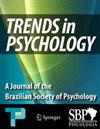墨西哥异性恋和LGBTQ成人虐待儿童的回顾性测量方法的发展
Q3 Psychology
引用次数: 0
摘要
儿童虐待是影响世界上很大一部分人口的一种现象,对他们的心理健康有重要影响。虽然存在一些测量工具,但它们存在一些需要改进的困难。本研究从先前为墨西哥人口开发的工具(Esparza-Del Villar等人,《人际暴力杂志》,2020年)开始,构建了一个新的虐待回顾性测量方法:成人儿童虐待量表(EAIA,西班牙语缩写)。我们总共研究了810个人,主要是女性(>70%)和年轻人(平均年龄在23岁左右)。我们采用了传统的(探索性和验证性因素分析)和先进的(探索性图表分析,项目反应理论)程序来获得儿童虐待经历的简短自我报告测量。EAIA具有清晰的因子结构(CFI = .96, RSMEA = .06),其三个子量表:性(ω = .91),身体(ω = .88)和精神虐待(ω = .93)具有足够的信度。此外,它在性别间表现出部分标量不变性。在项目水平上,我们观察到性虐待和身体虐待分量表的项目在高虐待水平上具有更大的信息容量,而情绪虐待分量表的项目在平均水平上表现出更好的心理测量质量。最后,EAIA的三个分量表与一组精神病理变量(抑郁、焦虑和自杀意念)呈预期方向相关。总之,EAIA是一种有希望的替代方法,可以对墨西哥成年人口中的虐待儿童行为进行回顾性测量。本文章由计算机程序翻译,如有差异,请以英文原文为准。
Development of a Retrospective Measure of Child Abuse for Heterosexual and LGBTQ Mexican Adults
Abstract Child abuse is a phenomenon that affects a large proportion of the world’s population and has important effects on their mental health. Although several instruments exist to measure it, they present some difficulties that require improvement. The present study started from an instrument previously developed for Mexican population (Esparza-Del Villar et al., Journal of Interpersonal Violence , 2020) to construct a new retrospective measure of abuse: the Child Abuse Scale for Adults (EAIA, Spanish initials). We worked with a total sample of 810 individuals, consisting mainly of women (> 70%) and young adults (mean age around 23 years). We conducted both traditional (exploratory and confirmatory factor analysis) and advanced (exploratory graph analysis, item response theory) procedures to obtain a short self-report measure of child abuse experiences. The EAIA evidenced a clear factor structure (CFI = .96, RSMEA = .06), as well as adequate reliability for its three subscales: sexual (ω = .91), physical (ω = .88) and emotional abuse (ω = .93). In addition, it showed partial scalar invariance between sexes. At the item level, it was observed that the items of the sexual and physical abuse subscales had greater informative capacity at high levels of maltreatment, while the items of the emotional abuse subscale showed better psychometric quality at average levels of the construct. Finally, associations were found in the expected direction between the three subscales of the EAIA and a set of psychopathological variables (depression, anxiety and suicidal ideation). In conclusion, the EAIA constitutes a promising alternative to retrospectively measure child abuse in the Mexican adult population.
求助全文
通过发布文献求助,成功后即可免费获取论文全文。
去求助
来源期刊

Trends in Psychology
Psychology-Psychology (all)
CiteScore
2.20
自引率
0.00%
发文量
121
审稿时长
48 weeks
期刊介绍:
Trends in Psychology is a quarterly publication of the Brazilian Society of Psychology. It is intended to disseminate original scientific work in all fields of psychology, such as empirical, historical, theoretical and conceptual studies, as well as reviews of literature.
 求助内容:
求助内容: 应助结果提醒方式:
应助结果提醒方式:


